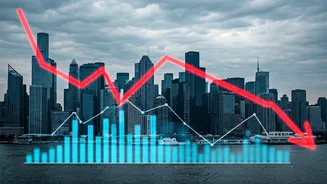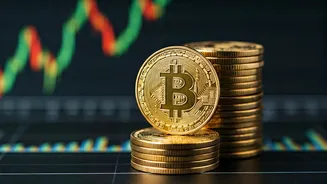Current Market Outlook
The recent downward trend in gold prices has spurred a variety of investor reactions. Some individuals holding substantial gains are contemplating partial
profit-taking, especially if gold's trajectory indicates a pattern of lower highs in the coming weeks. Conversely, this period of decline is seen by some as an ideal moment to enter the market. The short-term market outlook might be characterized by range-bound movements or a phase of consolidation. The US dollar's strength, the returns on US Treasury bonds, and the actions of the Federal Reserve will be important factors. Any escalation of geopolitical tensions or a shift towards a more accommodating stance by the Federal Reserve could trigger a rebound in gold prices. For new investors, strategies like systematic investment plans (SIPs) in gold exchange-traded funds (ETFs) or sovereign gold bonds can help in averaging costs and lowering timing risks.
Long-Term Considerations
Despite short-term volatility, the enduring appeal of gold for long-term investors remains robust. Key structural elements that bolster its value include continued buying activity by central banks, persistent inflation concerns, and geopolitical instability. Gold continues to be a strategic asset, especially for diversifying investment portfolios and safeguarding wealth. The primary drivers underpinning gold's lasting value remain intact, reinforcing its role as a solid investment for the future. Gold's historical performance as a safe haven and its inherent value continue to attract investors looking for stable returns amid economic uncertainties. Investors should stay informed about market movements and refrain from making hasty decisions driven by panic. Aligning investment strategies with long-term financial goals is key to navigating the gold market.
Central Bank Activities
Central banks worldwide are continuing to accumulate gold, as seen by the trends in the market. In the third quarter of 2023, these institutions collectively added 220 tonnes to their reserves, marking a 28% increase from the previous quarter. Several countries, including Poland, India, and Uzbekistan, were among the top purchasers of gold in November 2023. This ongoing acquisition reflects a strategic shift away from the US dollar and toward gold as a buffer against currency and geopolitical risks. While gold's prominence in central bank reserves is growing, it is still premature to assert it will fully replace the US dollar. The trend of de-dollarization is undeniably evident, however. Nations such as China, Russia, and India are diversifying their reserves, with gold's independent nature making it an appealing option amidst geopolitical fragmentation. This trend suggests a long-term shift in the global financial landscape, potentially increasing gold's valuation.
India’s Gold Demand
The Indian market witnessed mixed trends in gold demand following the Dussehra and Diwali festivals. While demand for jewelry decreased by 16% year-on-year due to high prices, investment demand saw a surge. Consumers directed their focus towards gold coins, bars, and ETFs, viewing gold more as a financial instrument than a ceremonial item. Although leading jewelers reported record sales during Diwali, this momentum eventually slowed down when prices declined. This shift towards investment-oriented gold products indicates a maturing investor base in India, with consumers becoming more discerning and focused on long-term value. Market dynamics suggest investors are adjusting to market conditions, and their increased financial sophistication continues to shape the gold investment landscape in the country.













